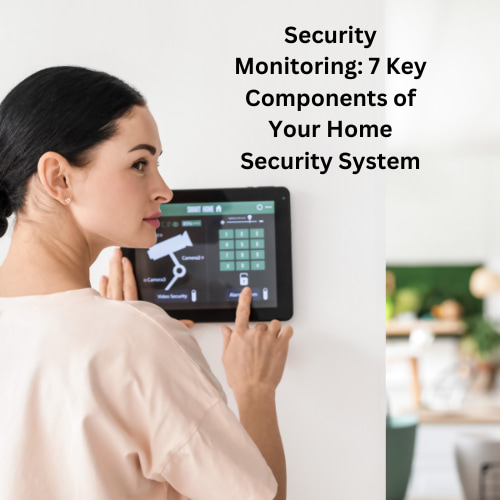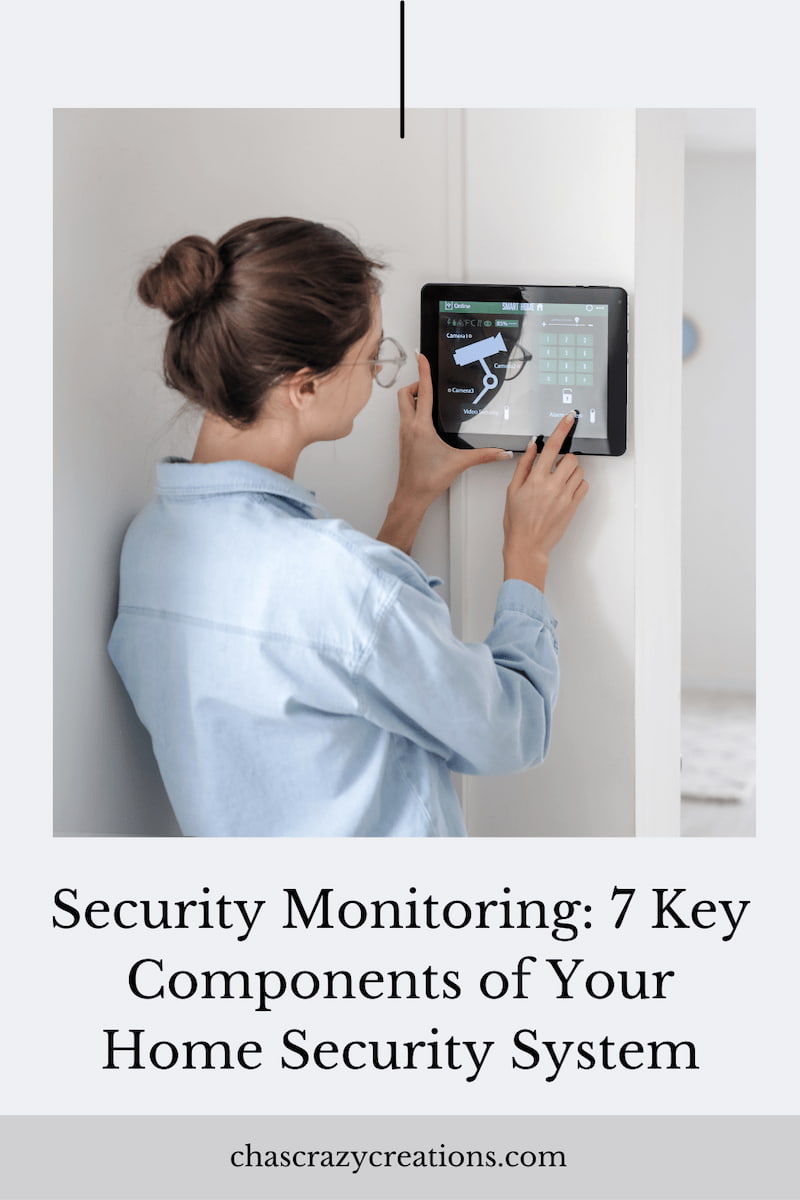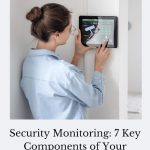Security Monitoring: 7 Key Components of Your Home Security System
Are you wondering about security monitoring? Your home security system functions as your ever-watchful protector. Modern systems consist of several essential components that operate in synergy to ensure the safety of you, your loved ones, and your valuable possessions.
This post may contain affiliate links, I earn from qualifying purchases at no extra cost to you. Click here for my disclosure policy
These diligent systems actively guard against numerous potential threats, often without fail. Moreover, their robust performance provides an unbroken shield that protects what is most important to you from security threats.
Whether you’re buying a new home, inhabiting an old one, or even building one from scratch, this piece is for you.
There are a number of network monitoring resources available, so how do you know which one is right for you? Here’s a list of elements you should consider as far as the home security system is concerned.

7 Key Components Your Home Security System Should Probably Have
1. Surveillance Cameras
Investing in surveillance cameras should be your first priority in constructing a home security system. They act as your eyes, effectively providing continuous security monitoring your property when you’re away or tucked up in bed. High-quality cameras can record clear footage, even at night… footage that can aid in threat detection and security incidents.
2. Alarm Systems
Next on the list are alarm systems, an essential part of any respectable home security layout. When suspicious activities are detected, these systems trigger loud alerts to deter any potential intruder – quickly bringing attention to the anomaly. In some cases, they’ll even send automated messages to local police.
3. Access Control Capabilities
Incorporating access control capabilities into your home security strategy brings a whole new level of protection. At the heart of these capabilities lie access control products and accessories, which offer you unrivaled management over who enters your home and when.
With everything from smart locks to keypads at your disposal, one thing is indisputably true. There’s an added layer of assurance that even if keys are lost or codes are forgotten, you always have the upper hand when it comes to access controls.
4. Home Automation
You might not have expected this, but integrating home automation into your security system can be tremendously powerful. With smart devices like automated lights or heating systems linked to your mobile device, you can create an illusion of presence even when not at home.
Any potential intruder may get discouraged by the apparent signs of occupancy.
5. Window and Door Sensors
These are one of the simplest yet most effective parts of a home security system. Besides, door or window replacement also paves the way to an energy-efficient home.
Sensors on windows and doors notify you when they’re unexpectedly opened or broken into, allowing you instant knowledge of any intrusion attempts. Such swift notifications enable quick actions to be taken when facing security threats.
6. Motion Detector Lighting
Incorporating motion detector lighting as part of your home security system is a smart move. It does more than just make your home look elegant. These clever devices sense movement and respond by immediately illuminating the area and any potential security threat.
If an unwelcome guest decides to creep around your property under the cover of darkness, they’ll unexpectedly find themselves in the spotlight, deterring them effectively. Also, it has the added convenience of improved visibility and lighting your path when you come home late at night.
7. Network Security Monitoring
Finally, having a reliable monitoring service rounds off your home security plan. This could be a professional monitoring service or (as earlier hinted) an intuitive mobile app that sends real-time alerts for any disturbances while you’re away.
By providing immediate notifications about potential threats, these services significantly enhance your chances of thwarting property damage or intrusion. Even more significantly, the peace of mind of knowing your home is consistently under watch is indeed priceless.
Shop any of these stores and I receive a small commission at no cost to you.
 Echo Dot (4th Gen, 2020 rel...Shop on Amazon
Echo Dot (4th Gen, 2020 rel...Shop on Amazon Apple AirTagShop on Amazon
Apple AirTagShop on Amazon Amazon Fire TV Stick, sharp...Shop on Amazon
Amazon Fire TV Stick, sharp...Shop on Amazon

Security Monitoring Q & A
Is a security monitoring system worth it?
Yes, a security monitoring system can be worth it, depending on your specific needs and circumstances. Here are some factors to consider when deciding whether a security monitoring system is worth it for you:
- Security Needs: If you have valuable assets, property, or sensitive information that you want to protect, a security monitoring system can provide an extra layer of security. This is especially true if you live in an area with a higher crime rate or if you frequently travel and want to keep an eye on your property remotely.
- Peace of Mind: A security monitoring system can offer peace of mind knowing that your property is being monitored 24/7. This can reduce stress and anxiety, especially if you worry about the safety of your loved ones or belongings.
- Deterrence: Visible security cameras and signs indicating the presence of a monitoring system can act as a deterrent to potential burglars or intruders. Many criminals are less likely to target a property that has visible security measures in place.
- Quick Response: Many modern security monitoring systems are connected to professional monitoring services that can alert authorities in the event of a security breach, fire, or other emergency. This can lead to quicker response times and potentially minimize damage or loss.
- Insurance Benefits: Some insurance companies offer discounts on homeowners or renters insurance premiums for properties with security systems. This could help offset the cost of the system over time.
- Remote Monitoring: Many security systems offer the ability to monitor your property remotely through mobile apps or web interfaces. This can be valuable if you want to check in on your property while you’re away or receive alerts in real-time.
- Customizability: Security monitoring systems come in various configurations, from basic alarms to comprehensive smart home systems. You can choose the level of coverage that suits your needs and budget.
- Resale Value: Having a security monitoring system installed in your property could potentially increase its resale value, as some buyers may consider it an attractive feature.
- Cost: While security monitoring systems come with upfront costs for equipment and installation, they can provide long-term benefits. Consider the initial investment versus the potential savings from preventing theft or damage.
- Privacy Concerns: It’s important to be aware of potential privacy concerns, especially if your security monitoring system captures footage of public areas or neighboring properties. Be sure to follow local laws and regulations regarding surveillance and privacy.
Ultimately, the decision of whether a security monitoring system is worth it depends on your individual circumstances, priorities, and budget. If you’re considering investing in a security system, it’s a good idea to research different options, read reviews, and consult with professionals to determine the best solution for your needs.
What does security monitoring include?
Security monitoring typically includes a range of services, technologies, and practices aimed at detecting, preventing, and responding to security threats and emergencies. The specific components of a security monitoring system can vary depending on the level of protection desired and the type of property being monitored. Here are some common elements that are often included in security monitoring:
- Surveillance Cameras: Security monitoring systems often include surveillance cameras strategically placed around a property to capture visual information. These cameras can provide real-time video feeds and recorded footage that can be reviewed later if needed.
- Intrusion Detection Systems (IDS): IDS are designed to detect unauthorized entry or access to a property. This can include door and window sensors, motion detectors, glass break detectors, and other devices that trigger alarms if a breach is detected.
- Alarm Systems: Alarm systems are a central component of security monitoring. When a sensor is triggered, such as a door being opened or motion detected, the alarm system sounds an audible alarm and can also send alerts to a monitoring center or directly to the property owner’s smartphone.
- Access Control: Access control systems regulate who can enter specific areas of a property. This can include keycard or keypad entry systems, biometric scanners (such as fingerprint or facial recognition), and remote access management.
- Fire and Smoke Detection: Security monitoring systems often include fire and smoke detectors that can alert occupants and monitoring centers in the event of a fire or presence of smoke.
- Environmental Sensors: These sensors monitor for environmental conditions such as temperature, humidity, and water leaks. They can help prevent damage caused by environmental factors and provide early warnings for potential issues.
- Video Analytics: Some advanced security monitoring systems use video analytics to analyze the video feeds from surveillance cameras. This can include object detection, facial recognition, and behavior analysis to identify suspicious or unusual activity.
- 24/7 Monitoring Centers: Many security monitoring systems are connected to monitoring centers staffed by security professionals who can receive alerts and take appropriate actions, such as contacting emergency services or notifying property owners.
- Remote Monitoring: Property owners can often access their security system remotely through mobile apps or web interfaces. This allows them to monitor their property in real time, receive alerts, and control various aspects of the system.
- Integration with Smart Home Devices: Some security monitoring systems integrate with other smart home devices, such as smart locks, lights, and thermostats, allowing for centralized control and automation of various aspects of the property.
- Emergency Response Services: In the event of an emergency, some security monitoring systems offer the option to connect directly with emergency response services, such as police, fire, or medical assistance.
It’s important to note that security monitoring systems can vary in complexity and features, and not all systems include all of these components. When considering a security monitoring system, it’s advisable to assess your specific security needs and research different options to find a system that aligns with your requirements.
What makes an effective security system?
Maintaining a robust home security system has become increasingly essential in today’s digital age, where vulnerabilities and cyber threats pose significant risks to our everyday lives. A comprehensive security monitoring setup encompasses several key components that work in harmony to ensure the safety of your home and your digital assets.
- Security Information and Event Management (SIEM) Platform: A SIEM platform serves as the backbone of your security infrastructure. It collects and analyzes security information from various sources, including servers, endpoints, and network devices. By correlating data and events, it helps in identifying security issues, vulnerabilities, and potential cyber threats. This platform forms the foundation of effective risk management, ensuring that your home’s cybersecurity posture is strong.
- Endpoint Security: Endpoints, such as computers, smartphones, and IoT devices, are potential entry points for cyber-attacks. Implementing robust endpoint security measures, including malware detection, intrusion prevention, and access controls, strengthens your overall security controls. This not only safeguards your data and sensitive information but also prevents unauthorized access to your home network.
- Continuous Monitoring and Event Management: Continuous monitoring of your home network and IT infrastructures is crucial to detect anomalies and potential cyber threats. By closely tracking network performance and event logs, you can proactively identify and mitigate security issues before they escalate. Additionally, efficient event management ensures that your security operations remain effective and agile.
- Compliance and Security Controls: Adhering to industry standards and best practices, such as those outlined by NIST (National Institute of Standards and Technology), helps ensure that your security monitoring system meets compliance requirements. Implementing strong security controls, protocols, and cybersecurity monitoring practices establishes a resilient defense against data breaches, ransomware attacks, and other cyber-attacks.
- Data Loss Prevention and Availability: Protecting sensitive data from loss or theft is paramount. Security monitoring involves not only detecting cyber threats but also ensuring data availability and integrity. Robust data loss prevention mechanisms, data backups, and disaster recovery plans contribute to a comprehensive cybersecurity strategy for your home.
- Correlating Cybersecurity Monitoring Ecosystem: Your security monitoring ecosystem operates within a network of interconnected components, including vendors, servers, and security solutions. Correlating information from these diverse sources enhances your ability to detect and respond to cyber threats effectively. This collaborative approach strengthens your security posture by ensuring comprehensive coverage.
- Ransomware Protection and Risk Management: Ransomware remains a significant concern for individuals and organizations alike. An integral part of your security monitoring system, ransomware protection mechanisms, and risk management strategies help prevent and mitigate the impact of ransomware attacks. Prompt detection and response are critical to minimizing potential damage.
In conclusion, a well-designed security monitoring system encompasses a diverse array of components, each playing a vital role in safeguarding your home and digital assets. By integrating security information, compliance measures, continuous monitoring, and risk management, you can establish a robust cybersecurity posture that effectively counters cyber threats and vulnerabilities. This proactive approach empowers you to maintain the availability, integrity, and confidentiality of your organization’s networks and critical data, ensuring peace of mind and a secure living environment.
In Conclusion…
In conclusion, building a robust home security system might seem like a daunting task, but understanding these seven crucial components can simplify your journey toward achieving it. Each one plays an indispensable role in maintaining the safety and sanctity of your home.
By exploring and thoughtfully integrating these factors into your home’s defense mechanism, you not only ensure a secure dwelling for you and your loved ones but also imbibe the tranquility that comes from knowing everything precious to you is well-protected. After all, there truly is no place like a secure, comfortable home.








